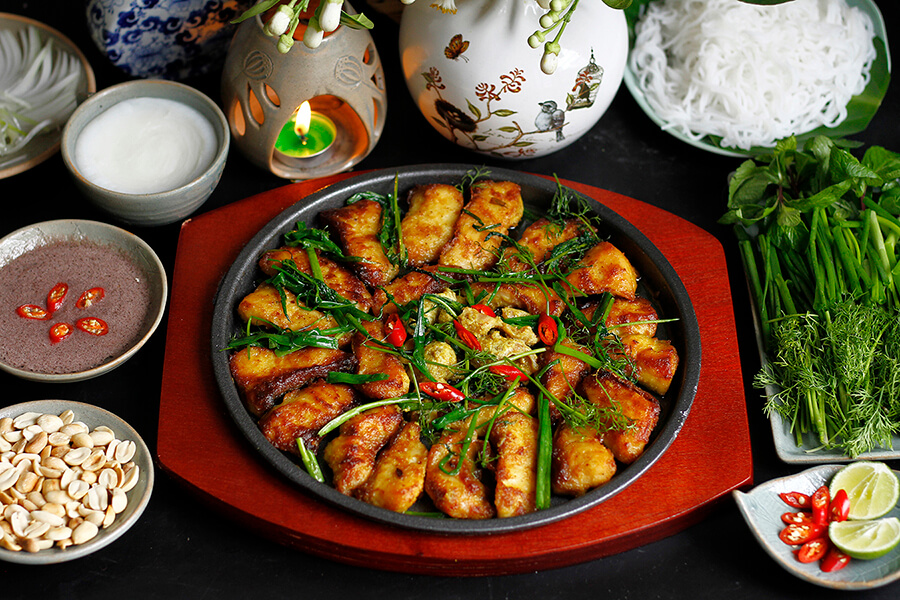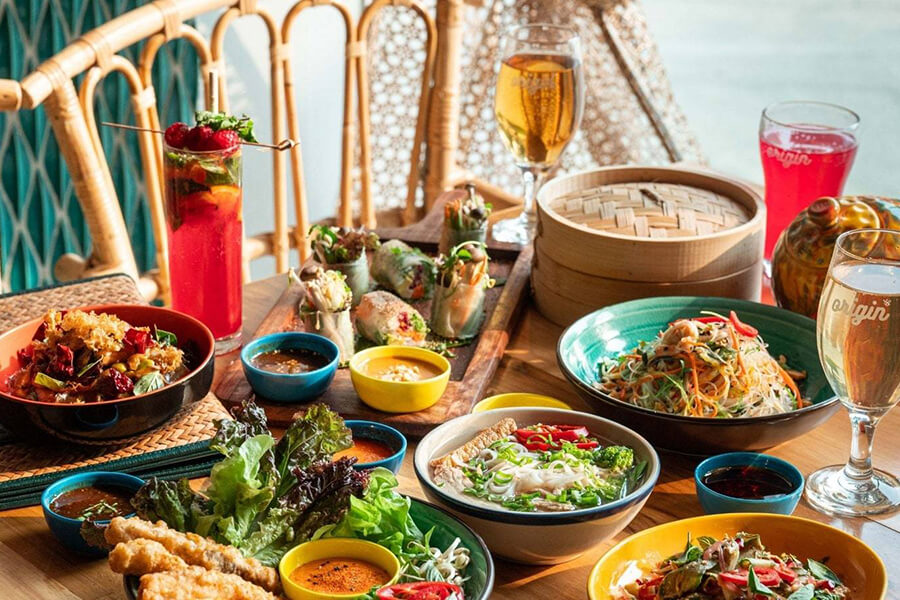In the realm of gastronomy, Vietnamese cuisine stands as a masterpiece adorned with intricate layers of flavor and a symphony of culinary finesse. It is a realm where each dish is a canvas painted with a fusion of spices and a harmonious blend of ingredients, captivating the palate with its diverse and rich tapestry of taste.
Vietnamese culinary artistry, however, is not a monolith; rather, it is a tapestry woven from regional diversity. Each province, each locale, boasts its distinct culinary customs, crafting dishes that carry the nuanced flavors and culinary heritage specific to that area. This beautiful diversity contributes to an opulent array of delectable delicacies, rendering Vietnamese cuisine an invaluable treasure trove of tastes.
The sophistication of simmering, the meticulous and artistic preparation, and the minimalist yet flavor-forward approach all converge in this culinary landscape, creating an unparalleled experience for the taste buds. The intricate amalgamation of spices and the precise balance of flavors evoke a sensorial journey that is both unique and unforgettable, making Vietnamese cuisine an irreplaceable gem in the world of culinary delights.
VietNam dry food
Banh Mi VietNam – Bread
Bánh mì, a culinary treasure of Vietnam, presents itself as a delectable symphony enclosed within a crusty exterior, embracing a plethora of tantalizing fillings nestled within a soft, yielding crumb. Its essence dances on the taste buds, inviting a sensory journey deeply rooted in Vietnamese culture and tradition.
In this culinary canvas, the artistry of bánh mì allows for a diverse selection of fillings, each reflecting the tapestry of regional flavors and personal inclinations. However, traditional variations often showcase the richness of Vietnamese pork roll, an array of meats, seafood, vegetarian options, or even the sweetness of fruit jams, harmoniously accompanied by ingredients like velvety pâté, creamy butter, vibrant vegetables, zesty chili, and crisp pickles. This amalgamation of flavors creates a symphony that harmonizes affordability with exquisite taste, rendering bánh mì a beloved choice for a quick, satisfying meal—whether embraced as breakfast or savored at any moment throughout the day.
The genesis of Vietnamese bánh mì can be traced back to the introduction of the baguette by the French to South Vietnam in the 20th century. Some historical accounts even suggest its presence in Vietnam a century and a half ago. Over time, bánh mì transcended across the Central and Southern regions, notably flourishing in Saigon. The Saigonese artisans ingeniously transformed the baguette, crafting smaller loaves with a hollowed core, approximately 30–40 cm, a canvas that could cradle an assortment of fillings, reminiscent of a sandwich. With diverse fillings came varied nomenclature, adding a unique touch to each bánh mì creation. This versatile delight often partners with an array of dishes, from sumptuous beef stew to savory sardines or flavorful meatballs, elevating its culinary versatility.
In the wake of the Vietnamese diaspora post-1975, bánh mì became a global sensation, permeating across continents and cultures. Its ubiquity in countries hosting Vietnamese communities owes itself to the simplicity of its preparation and the ease of sourcing its ingredients, seamlessly blending with diverse culinary customs. Embraced in the common parlance of American English, “bánh mì” found itself Anglicized as “banh mi,” distinguishing itself from similar sandwich-like dishes. Notably, in March 2012, Saigon’s bánh mì earned prestigious accolades when The Guardian’s travel website honored it among the top 10 most delectable and enticing street foods globally, celebrating its irresistible charm and rich heritage.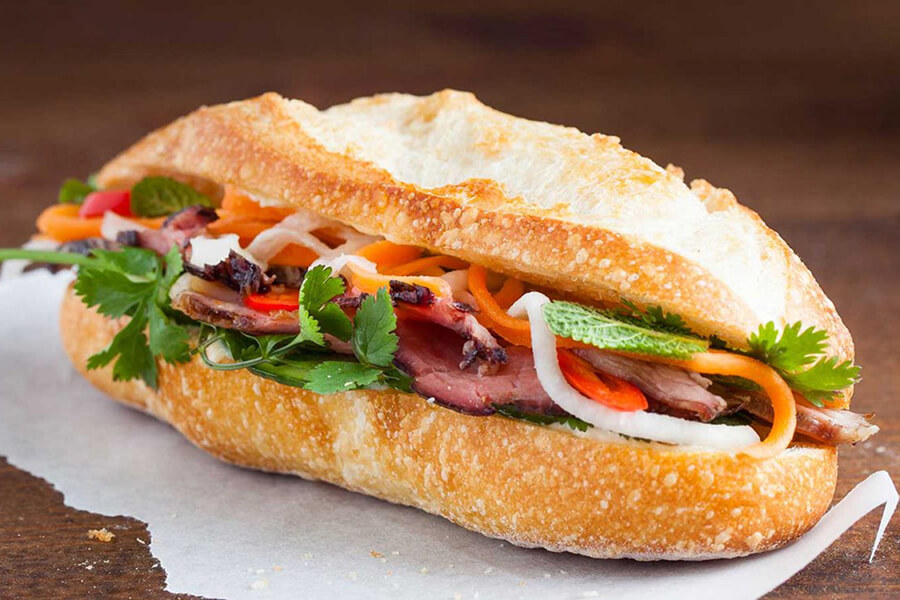
Cơm Tấm VietNam – broken rice
In its humble origins, cơm tấm emerged as a sustaining meal cherished by impoverished rice farmers dwelling in the verdant expanse of the Mekong Delta, a dish born from economic adversity and resourcefulness. The toil of bad rice seasons rendered good rice scarce, compelling these hardworking farmers to utilize broken rice, fragments left from handling processes, once deemed inferior during that era. However, these rice remnants, abundant and accessible within the farmers’ humble abodes, provided a sustaining sustenance, satiating their hunger through trying times.
Amidst Vietnam’s urbanization, particularly during the early 20th century, the popularity of cơm tấm transcended its rural roots, blossoming across the Southern provinces, notably finding its place in the vibrant streets of Saigon. As the city thrived as a melting pot of diverse cultures, food purveyors ingeniously adapted cơm tấm to cater to the palates of international patrons—be they French, American, Chinese, or Indian. This evolution saw the addition of succulent grilled pork, the comforting presence of chả trứng (Vietnamese-style steamed omelet with pork), and a shift from traditional bowl-and-chopstick servings to plate presentations paired with forks.
Today, cơm tấm has transcended its modest beginnings, evolving into a beloved icon ingrained within Saigon’s cultural tapestry, adored by individuals from all walks of life. It stands as a ubiquitous symbol, a culinary heritage that unites Saigonese in a shared passion for its flavors and history. The metaphorical saying, “Saigon people eat cơm tấm like Hanoi people eat…,” encapsulates its significance, signifying not just a meal but a part of the city’s very essence, an emblem of unity and shared identity.
Ingredients broken rice
Crafted with meticulous precision and a symphony of flavors, the celebrated “Cơm Tấm Sườn Bì Chả” boasts an ensemble of carefully selected ingredients that converge to create a palate-pleasing Vietnamese delight. At its heart lies broken rice, a grain fragmented by milling processes, revered in Western kitchens as an industry ingredient yet cherished in West Africa and Southeast Asia for direct human consumption. In this dish, it takes center stage as the cornerstone, each grain a testament to resilience and resourcefulness rather than deficiency.
Embracing the ensemble, succulent Sườn nướng—grilled pork ribs—charred to perfection, exude a tantalizing aroma and tender juiciness, while Bì, a delicate harmony of thin strands of pork and cooked pork skin seasoned with roast rice powder, adds a nuanced texture and depth to each bite. A cornerstone of the composition, Chả trứng, a Vietnamese-style steamed omelet with meatloaf, or in contemporary renditions, an omelet or fried egg, complements the medley with its comforting familiarity.
A melody of colors and freshness unfolds with the addition of various vegetables—crisp slices of cucumber and tomato, alongside the tangy vibrancy of pickled carrot and radish, forming an intricate dance of textures and tastes. The presentation wouldn’t be complete without the garnish of scallions, delicately chopped and lightly fried in heated oil until their essence softens, imparting an aromatic flourish to the dish.
The pièce de résistance comes in the form of a small bowl brimming with mixed fish sauce (Nước mắm pha), an essential and multifaceted condiment, heralded for its sweet, sour, salty, savory, or spicy notes. This sauce stands as the unifying element, inviting a sensorial journey that elevates each bite, harmonizing the diverse elements of this revered “Cơm Tấm Sườn Bì Chả” into a culinary masterpiece, where history, culture, and flavors intertwine.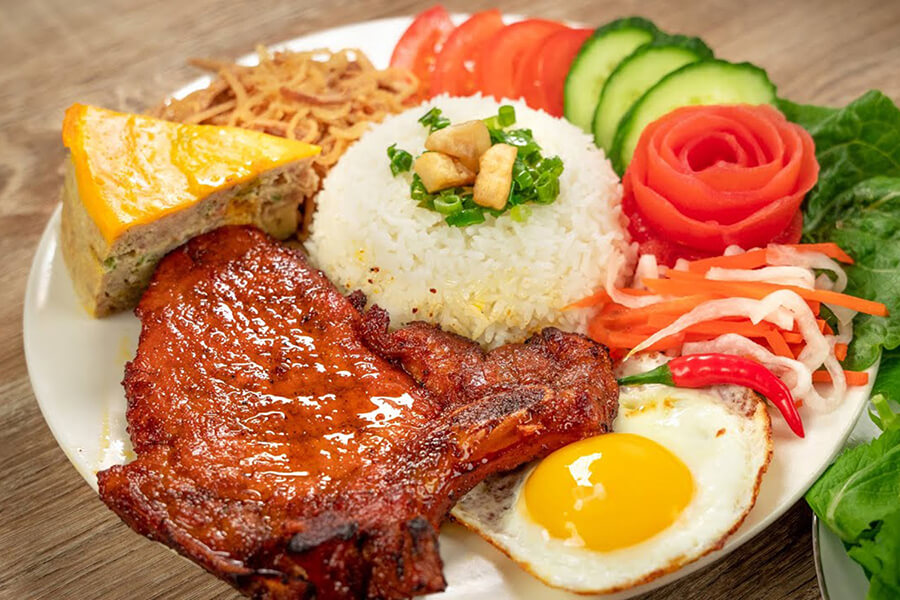
Bánh Xèo VietNam – pancakes
Imagine the sizzle echoing in the kitchen, the fragrant dance of tantalizing aromas teasing your senses. The bánh xèo emerges, a culinary marvel, boasting an enticingly crisp and delicate golden-brown crust that cradles a treasure trove of flavors within. Delicately crafted, it unveils a mosaic of succulent pork and shrimp, interspersed with delightful morsels of mung beans, onions, and the tender crunch of bean sprouts.
This culinary gem, often referred to as a Vietnamese pancake or crêpe, is not just a dish; it’s an experience meant to be shared, to bring families together in a delightful culinary embrace. As the batter sizzles in the pan, anticipation mounts for the hands-on ritual that follows – a delightful interactive affair where each diner customizes their creation, enveloping these savory delights in fresh, crisp veggies and dipping them into a flavor-packed sauce.
Crafting bánh xèo is a communal affair, resonating with the spirit of shared experiences and conviviality. It’s not just about assembling a modest portion of pork or a handful of shrimp; it’s about elevating the art of dining into a shared symphony of flavors, where each ingredient, each meticulous preparation, serves a greater purpose—to create a feast that unites and brings joy.
While these delectable crêpes may demand a bit of forethought and preparation, the rewards are bountiful. Once the rhythm is established, these culinary treasures can be conjured swiftly, keeping pace with the eager appetites of your gathering, each one eagerly devoured as soon as it emerges from the skillet. The moments spent together, creating, assembling, and enjoying these bánh xèo, echo with the laughter and delight shared in a meal meant for more than mere sustenance.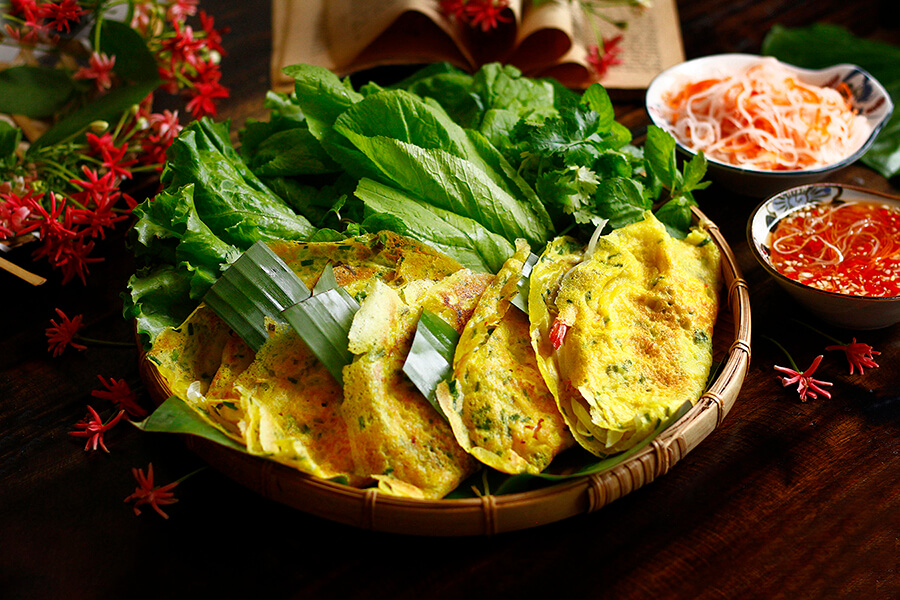
Vietnamese food with water
Phở VietNam – pho
Originating from Vân Cù in Nam Định, phở stands as a timeless emblem of Vietnamese culinary heritage, a revered hallmark of the nation’s cuisine that has transcended generations.
At its core, this revered dish boasts phở noodles submerged in a rich, aromatic broth, harmonizing with thinly sliced beef or chicken. The essence of phở lies not just in its ingredients, but in the careful selection of beef, often derived from indigenous cattle breeds like the golden hued or nội cows, contributing to its distinctive flavors. Infused with a symphony of flavors, the broth bears the imprints of hoisin sauce, black pepper, lime, fish sauce, chili, and a medley of other seasonings, tailored to individual tastes. It’s a delicately balanced orchestra of flavors, offering a spectrum of taste experiences for each diner.
Traditionally savored as a morning indulgence or as a late-night delight, the allure of phở knows no temporal bounds, finding its place on the tables of major cities at any hour. In the Southern provinces and other regions, phở arrives adorned with a platter of vibrant fresh herbs, including onions, bean sprouts, and an array of coriander, where the distinctive aroma of culantro leaves adds a signature touch. However, in Hanoi, it’s customary to serve phở without this side plate of raw herbs, showcasing a regional variation in presentation and taste.
This dish, often centered around beef or chicken, encompasses a spectrum of variations, from the traditional beef or chicken phở to innovative renditions like wine sauce phở, dry phở, stir-fried phở, sour phở, or regional specialties like duck phở in Cao Bang and roasted meat phở in the northern mountainous provinces.
The soul of phở resides in the alchemy of its broth—an elixir born from simmering beef or pork bones infused with an array of spices, from the warmth of cinnamon and star anise to the earthy tones of grilled ginger and cardamom. It’s this artful concoction that defines the essence of each spoonful. The selection of beef, featuring different cuts, or the shredded meat of an aged native chicken, adds depth to this culinary masterpiece.
The foundation of this sensory symphony, the phở noodles themselves, are an art crafted from rice flour, meticulously flattened into thin sheets and intricately cut into strands. To savor the true essence of phở, it must be enjoyed piping hot, the aromatic steam rising like a prelude to a flavorful journey. Ultimately, the mastery of the cook, especially in perfecting the broth, marks the pinnacle of a memorable and delightful phở experience.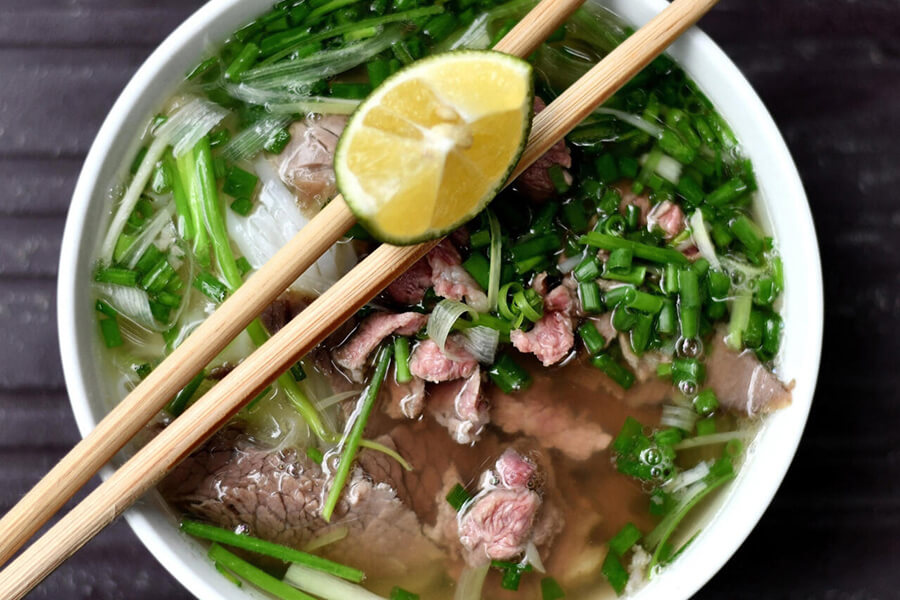
Bún Chả VietNam – Bun cha
Bún chả, originating from the northern realms of Vietnam, presents a culinary tapestry interweaving strands of slender bún, succulent grilled pork, and an exquisite, harmoniously balanced dipping sauce—a culinary treasure that perpetuates as Hanoi’s timeless culinary legacy. It stands distinguished in its realm despite sharing shades of familiarity with bún thịt nướng found in the Central and Southern regions, boasting a sauce exuding a milder, more nuanced palette of flavors.
At the heart of the feast lie the dual protagonists—chả viên (meatballs) and chả miếng (pork slices)—each offering a distinctive culinary narrative, offering patrons the privilege to choose based on personal predilections. Chả viên, sculpted from minced pork shoulder, intricately seasoned with a melange of salt, pepper, fish sauce over 35°N, sugar, finely diced dried shallots, and a dash of vegetable oil or rendered fat. Should the meat texture appear slightly desiccated post-seasoning, a touch of oil enriches the mixture, ensuring the formation of finger-sized patties, delicately flattened for consistency. For those who relish a more elaborate touch, each piece of chả is gently enfolded in banana leaves before meeting the searing flames, entwining tenderness with an augmented aroma.
The selection of pork shoulder for chả denotes a discerning choice, embraced for its lean, less fibrous nature, ultimately yielding denser and more robust meat patties than their counterparts crafted from alternate cuts.
In contrast, chả miếng, commonly fashioned from lean pork neck or pork belly, is thinly sliced, adeptly seasoned akin to its chả viên counterpart, then gently charred over smoldering charcoal until aglow in a golden hue. Diners have the liberty to opt for either chả miếng or chả viên to escort the bún. These succulent pork slices are often meticulously stripped of their skin to evade rigidness and avoid charring during grilling. The usage of pork shoulder or leg meat tends to stave off the risk of yielding dry and sinewy chả.
Post-marination, the delicately treated meat is either threaded onto skewers or arranged on a grill rack above smoldering charcoal. Upon attaining a heady aroma and an exquisite golden brown, these masterfully grilled meats are enshrined in a vessel of a robust, intricate sweet, tangy, and piquant dipping sauce, juxtaposed with strands of green papaya (or radish, carrot) soaked in vinegar. This flavor-laden ensemble beckons diners to partake, accentuating the bún experience amidst a verdant bed of raw veggies—crisp lettuce, aromatic coriander, invigorating mint, basil, perilla, and tender bean sprouts.
The bún used in bún chả today typically features bún rối, though the historical foundation was bún con—neatly bundled and compactly coiled bún, steeped in tradition. The streets of Hanoi are still graced by wandering vendors offering bún chả, evoking hints of cà cuống essence amidst stacks of fresh bún leaves, embodying an irreplaceable essence of the old Hanoi, immortalized in the writings of revered luminaries like Vũ Bằng and Thạch Lam.
The preparation of bún chả, though seemingly straightforward, veils a multitude of nuances and ancestral wisdom, especially in the fine art of orchestrating the dipping sauce’s flavor symphony—blending sour, sweet, salty, and tangy undertones in perfect harmony.
Hủ Tiếu VietNam – noodles
“Hủ tiếu” derives from the Teochew word “粿條” guê2diou5, pronounced as “quả điều” in Han-Vietnamese. It is also spelled as “hủ tíu” in the Southern Vietnamese dialect, where “tiếu” has a similar sound to “tíu.” This dish features noodle-like rice products and has its roots among the Teochew and Mân Nam communities, sharing resemblances with Cantonese sa hà fun and the Khách Gia people’s bán điều. Over time, this culinary tradition has spread to various regions within and beyond China, becoming a staple in South China and Southeast Asian countries like Southern Vietnam, Cambodia, Laos, Thailand, Singapore, and more.
Hủ tiếu has witnessed remarkable growth in Southern Vietnam since the 1950s, particularly in Saigon, where hủ tiếu eateries line the streets, and mobile hủ tiếu vendors can be found at the entrances of alleyways. It can be aptly stated that “hủ tiếu” is an iconic dish in this region, much like pho in Hanoi or bun bo in Hue. Hủ tiếu is typically enjoyed for breakfast or dinner, as people from the Southern region tend to have fewer meals at midday involving hủ tiếu.
The core elements of hủ tiếu consist of hủ tiếu noodles, and the primary broth is crafted with finely minced meat and pig’s heart. Following this, the hủ tiếu noodles undergo a brief parboiling with the broth, after which additional ingredients such as bean sprouts, chives, and minced meat are introduced. It can be accompanied by beef balls and chili sauce, as well as a black bean sauce.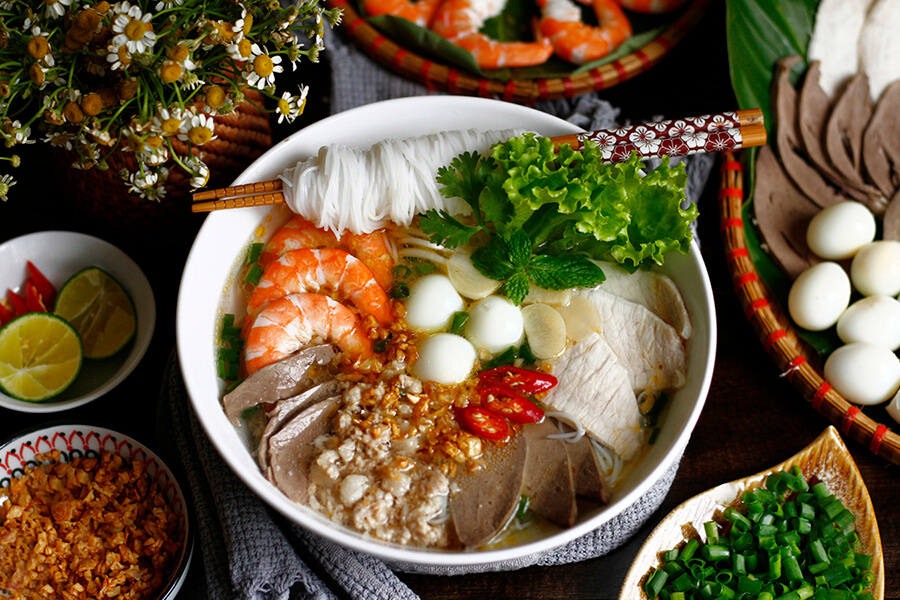
Bún Bò Huế VietNam – Beef rice noodle soup hue
“Bún bò,” an iconic Vietnamese dish that finds its roots in Huế, stands as a revered delicacy, transcending borders to become a culinary delight across the three regions of Vietnam and within the Vietnamese diaspora. The heart of Huế embraces this dish simply as “bún bò” or specifically as “bún bò thịt bò.” In various other places, it goes by names such as “bún bò Huế” or “bún bò gốc Huế,” celebrating its illustrious origin.
At its core, this dish boasts a harmonious blend of bún, delicate vermicelli noodles, beef shank, and succulent pork knuckles, all resting in a broth known for its captivating reddish hue and a tantalizing lemongrass-infused essence. While embracing tradition, it occasionally adds rare beef slices, crab sausage, and a medley of other preferred ingredients, elevating the flavor profile to an individual cook’s distinct touch.
In the kitchens of Huế, crafting the broth is an art form. Locals artfully season it with a whisper of shrimp paste, infusing the brew with the unique and signature flavor that distinguishes Huế’s bún bò. As the beef bones gently simmer, a subtle addition of minced pork or crab sausage enriches the aroma. Thinly sliced beef, adorned with a tender touch, briefly submerges in the simmering broth, infusing it with an exquisite taste, a step known as thịt bò tái. The final touch comes with a sprinkle of chili powder and carefully selected spices, enhancing the intricate flavors dancing within the bún bowl.
This culinary masterpiece is not complete without the company of fresh, crisp greens. Bean sprouts, aromatic herbs, vibrant lettuce, delicate baby mustard greens, and finely chopped banana flower grace the meal, elevating its sensory experience to unparalleled heights.
How to Cook most Popular Vietnam Dish
Step1
Gently cleanse the vibrant lemongrass and pungent ginger, allowing the fragrance to unfold as they’re meticulously washed and softly crushed. With the pork knuckles, it’s a careful cleanse, ensuring the bones are meticulously purified, ready for the flavorful creation. Envision rolling up the pork knuckles with the precision of a seasoned artist, securing the delectable morsels tightly using either the deftly tied kitchen twine or thinly sliced binds for that perfect arrangement. Much like an ancient craft, the beef brisket is lovingly encased, molded by hand into a neat, rounded form and fastened securely, akin to an artisan’s masterpiece. Every secure knot tied with kitchen twine is not just about culinary craftsmanship but also about preserving the integrity of the flavors as it simmers slowly.
step2
In a large pot of bubbling water, submerge the bones, brisket, tendons, and pork knuckles, blanching them to perfection and meticulously skimming off any impurities to ensure a visually appealing dish. Afterwards, delicately carve the tendons into perfectly sized pieces. Create a meld of three tablespoons of rich, aromatic Hue shrimp paste mixed with a precise half cup of water, stirring until it amalgamates seamlessly. Let the essence of the seasoning infiltrate the meat, soaking them in a marinade fashioned from two tablespoons of sugar, one tablespoon of salt, half a tablespoon of savory seasoning powder, one tablespoon of the diluted, fragrant Hue shrimp paste, alongside the harmony of two tablespoons of finely chopped purple shallots, two tablespoons of minced garlic, and two tablespoons of lemongrass, crushed to release its distinctive aroma.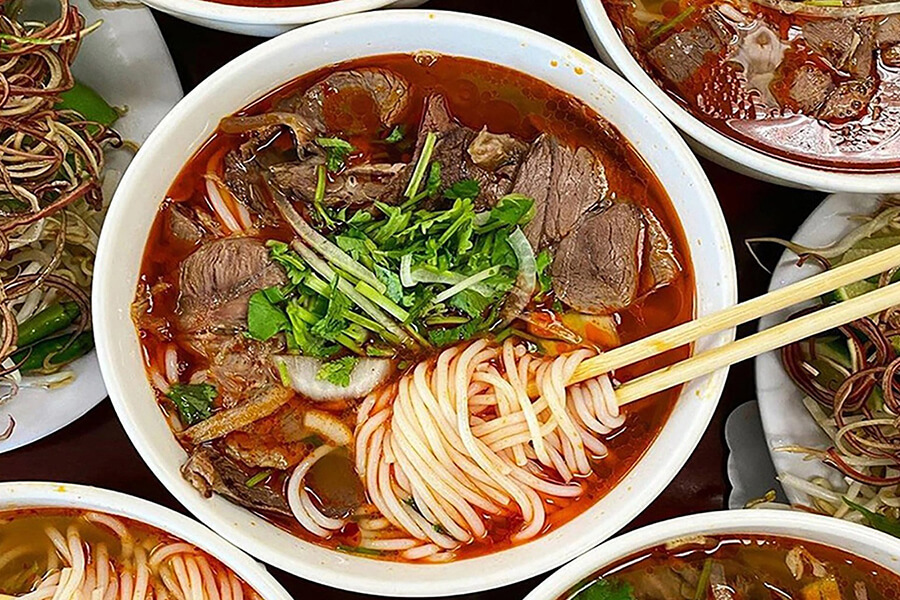
step3
Allow the meats and bones to mingle in a harmonious simmer, letting three fragrant lemongrass stalks and a portion of ginger grace the bottom of the pressure cooker. Immerse the pork bones and knuckles, ensuring they are just submerged under a careful pour of water. Seal the lid securely and wait for that anticipated soft sizzle and bubble of the boiling water. After this, lower the heat to a gentle murmur and let it serenade the ingredients for another five minutes. Gently pluck out the pork knuckles, letting them bathe in a bowl of cool water, ensuring their tender meat remains robust and free from sogginess.
Refresh the aromatic medley in the base of the pressure cooker with the remaining lemongrass and ginger. Then, introduce the beef brisket, shank, and the delicate tendons to this flavorful pool, covering them all with a serene pour of water. Lock the lid in place once more, and as the sounds of a hushed boil commence, reduce the heat, letting them all dance in their flavorful concoction for another satisfying 20 minutes. Now, gracefully escort the beef brisket and shank to a bowl of invigoratingly cool water, allowing their textures to grow firm and succulent.
step4
Merge the essence of beef and bone broths in a generously sized pot, gradually infusing the concoction with cold water until it culminates at 5 liters. Position the pot atop the stove, allowing the contents to gracefully ascend to a harmonious simmer. Imbue this union of liquids with a symphony of flavors – 3 tablespoons of fish sauce, 2 tablespoons each of salt and sugar, 2 tablespoons of seasoning powder, and the diluted yet potent essence of Hue shrimp paste. Taste the broth and meticulously fine-tune the seasonings until they resonate harmoniously on the palate.
The next act unfolds with an aromatic performance. Initiate a delicate dance in a pan by orchestrating 2 tablespoons of oil, sautéing a masterful blend of 1.5 tablespoons of minced lemongrass and 1 tablespoon of minced garlic. Wait for the crescendo of crispness and an aromatic opus, then introduce the grand entrance of 2-3 tablespoons of annatto oil, painting the dish with its rich color and deep resonance. The culinary overture harmoniously blends into the symphony of the simmering bone broth, creating a culinary masterpiece.
Preparing the herb platter requires an artist’s touch. Delicately sculpt a hint of cilantro, green onions, and shallots into a verdant melange. The pork is elegantly sliced with finesse. The vermicelli, soon to become the canvas for this artful presentation, is gently baptized in boiling water, ensuring a softened and inviting texture. Each element is meticulously arranged – the meats, the tender tendons, the savory meatballs, and the verdant sprinkle of fresh herbs – together forming a picturesque landscape.
Served alongside the orchestration, the lineup includes blanched water spinach, elegantly julienned banana flowers, crispy bean sprouts, and vibrant wedges of lime partnered with the dance of chili. As the curtains rise, the stage is set for a symphony of flavors that enchant the senses and enrapture the taste buds.
Vietnamese food rolls
Bánh Cuốn VietNam – Steamed Rice Rolls Stuffed
Crafted from finely wet-milled rice flour, the resulting cake texture is delicately smooth. Steamed to perfection, these cake sheets are carefully rolled, encapsulating a blend of savory meat, wood ear mushrooms, and cooked shiitake mushrooms. With a skilled hand, the baker segments these rolls into four smaller sections, presenting them artistically on a plate. The finishing touches involve a delicate sprinkle of dried shrimp atop the cake rolls, complemented by the gentle addition of fresh herbs like mint, coriander, and more. This exquisite ensemble is best enjoyed in harmony with a bowl of dipping sauce, enriched by a few slices of Vietnamese sausage and crisply fried shallots.
Thành Trì Rolled Cake stands as a revered delight among the locals of Hanoi, a prized specialty originating from Thành Trì ward within the Hoàng Mai district of Hanoi. These delicate cakes, made from aromatic Gie Cánh rice, are thinly layered like sheets of paper. Typically void of fillings, they are traditionally assembled in layers, nestled within a container and wrapped in fragrant lotus leaves, banana leaves, or dong leaves. Traversing the streets of Hanoi, vendors gracefully carry these stacked cakes in a container balanced upon their heads. Upon encountering eager patrons, they meticulously unfold the layers, ensuring the integrity of each sheet. The cake’s surface is garnished with golden-brown fried spring onions, meticulously presented on a plate where each layer is carefully arranged side by side. A knife skillfully divides the entire stack in half, allowing diners to marvel at the exquisite layers. When served, the cake is accompanied by a uniquely crafted dipping sauce, often accompanied by delectable complements like cinnamon pork sausage, Vietnamese pork loaf, fried tofu, and fresh coriander.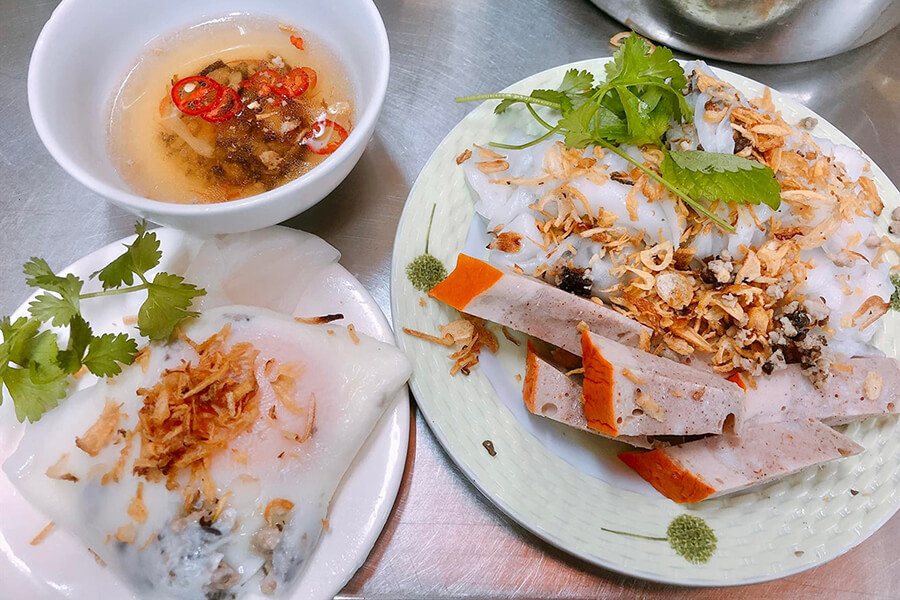
Phở Cuốn VietNam – Pho Rolls
Crafted from a blend of rice flour, the rice paper radiates natural shades, signifying its wholesome origins. The rice paper rolls are an amalgamation of delightful elements, entailing dried shrimp, the delightful crunch of fried shallots, the nutty essence of peanuts, and the subtle tang of shrimp paste and mayonnaise. At times, these flavorful parcels contain the tender allure of pork, the refreshing presence of cucumber, delicate vermicelli, and a medley of fragrant herbs.
Animal-based components undergo meticulous preparation involving boiling, sautéing, and frying techniques to accentuate their textures before being meticulously sliced into small, slender, or finely cut pieces.
Vibrant, crisp lettuce, along with a variety of freshly picked herbs, and an assortment of diverse vegetables, are carefully cleansed and sliced into bite-sized morsels or slender julienne strips.
The rice paper, a canvas for this culinary artistry, is meticulously softened and crafted into rectangular pieces, approximately 10x20cm. However, if using the pre-cut, pliable rice paper squares, this preparatory step can be conveniently omitted.
How to Cook most Popular Vietnam Dish
step 1 – material processing
Crafted from rice flour, the rice paper features an all-natural hue. The delectable rice paper rolls are stuffed with an assortment of ingredients including dried shrimp, crispy fried shallots, crunchy peanuts, seasoned shrimp paste, and a touch of creamy mayonnaise, occasionally complemented by succulent pork, refreshing cucumber, delicate vermicelli, and a mix of fragrant herbs.
Animal-based components are meticulously cooked through boiling, sautéing, and frying, ensuring tenderness, and then finely sliced into small, slender cuts or julienne pieces.
Fresh lettuce, an array of vibrant herbs, and assorted vegetables are meticulously washed and meticulously sliced into bite-sized portions or thin, lengthy strips.
The rice paper is gently softened and precisely sliced into rectangular pieces measuring about 10x20cm. When using pre-cut, pliable rice paper squares, this preparatory step is effortlessly bypassed.
step 2 – Make dipping sauce
The zesty, tangy fish sauce combines the flavors of vinegar, sugar, garlic, and chili, creating a symphony of sweet, sour, and spicy notes. Across different regions, variations emerge in perfecting this sauce: some kitchens bring in the rich essence of roasted rice powder, the pungency of finely ground scallions and garlic, and the subtly smooth touch of coconut water, meticulously simmering this blend to achieve a luscious texture. A distinctive touch found in the heart of Hanoi involves infusing the sauce with a dash of fermented glutinous rice, adding depth to both the sauce and the filling of the nem. In select locales, a unique twist involves soaking salt-squeezed julienned turnips and carrots in warm water, blending them with zesty garlic, fiery chili, and a splash of lime juice, contributing a refreshing zest to the fish sauce.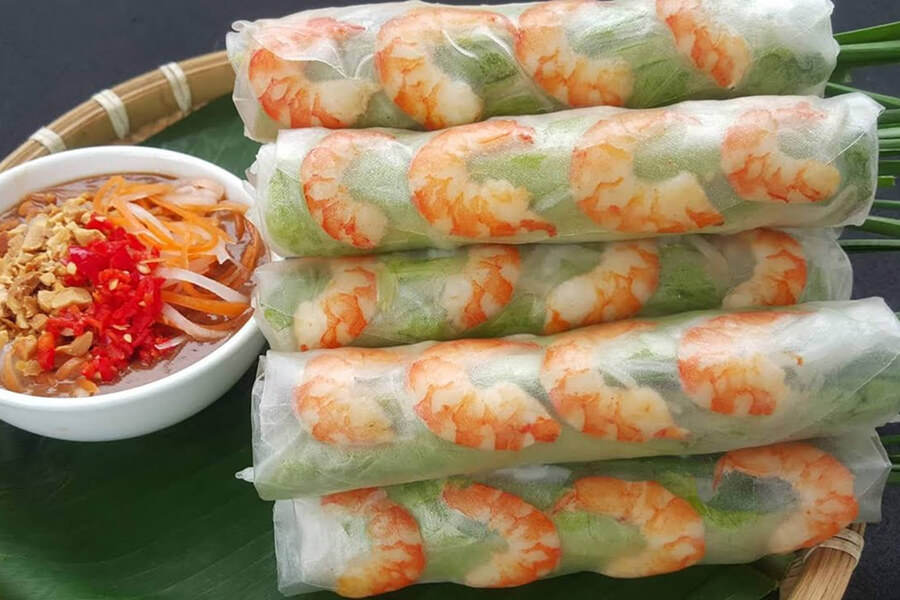
step 3 – Roll rice paper
Positioning a variety of prepared ingredients in assorted bowls and plates across the dining table offers a delightful opportunity for guests to fashion their own nem rolls, tailoring each piece with their favored components and delicately dipping it into the fish sauce or condiment. Once the ingredients are artfully placed onto the rice paper, the paper is meticulously folded and sliced into bite-sized portions, ensuring effortless indulgence. Vendors thoughtfully encase these delectable rolls in foam containers, adorning them with skewers, an elegant solution to preserve a dining experience devoid of the necessity to employ one’s hands. Restaurants elegantly showcase their offerings by preparing pre-rolled nem meticulously arranged on serving plates, a visually enticing gesture for their patrons. Each nem roll entails the precise placement of a rice paper sheet, adorned with layers of crisp, vibrant herbs like lettuce, gradually assembling the ingredients before a graceful roll. The addition of coriander leaves along the length of the roll not only enriches the flavor but also serves as an appealing visual enhancement, creating an inviting and delightful dining experience.
chả cá – grilled chopped fish
Fish cake, a savory delicacy, finds its origins in Asia, crafted primarily from a blend of fish, sugar, water, flour, and often accompanied by beef, resulting in a distinctive Asian-style composition. To create this culinary delight, a mixture of fish meal and surimi is expertly shaped and cooled, then meticulously enveloped in a flour coat through the intricate workings of a specialized machine. These delectable morsels are carefully immersed in scorching oil, sizzling at temperatures of approximately 180°C (356°F), ensuring an interior heat of 75°C (167°F) is achieved. Once cooked to perfection, they are meticulously frozen and packaged, preserving their flavors until they are ready to be relished.
In the European culinary sphere, the fish cake is akin to the European-style crispy potato cake, featuring fish fillet or various seafood blended with potato starch. Sometimes, they are enveloped in a crunchy breadcrumb layer or a luscious batter. As outlined in the Oxford Food and Nutrition Dictionary, the concept of a fish cake comprises finely minced or blended fish integrated with potatoes, eggs, and a blend of traditional spices, garlic, chili, and occasionally, a sprinkle of fragrant herbs, delivering a delightful flavor profile that appeals to the senses.